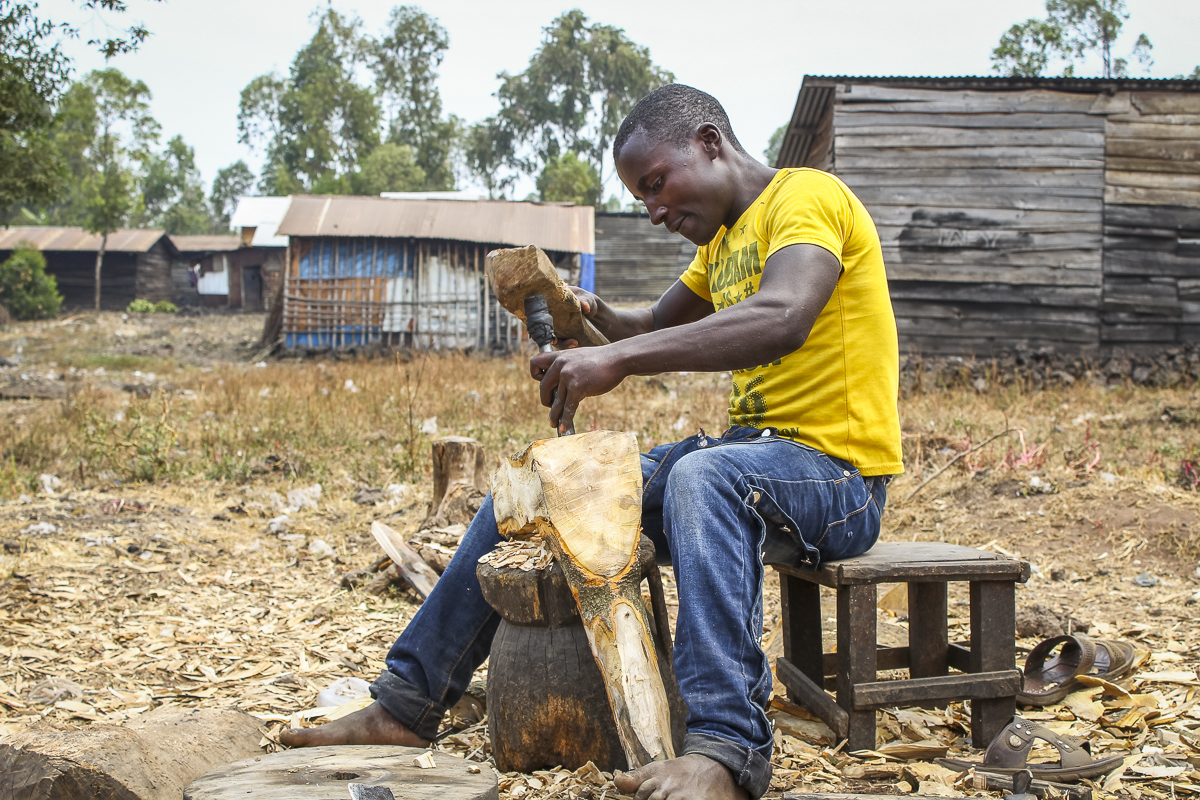
Ley Uwera, GPJ DRC
Chukudus are wooden, two-wheeled vehicles powered only by the people who push them. The vehicles are a common sight in Goma, the capital of North Kivu province in Democratic Republic of Congo. Vendors say they prefer to ship goods via chukudus instead of other vehicles because chukudus don’t require costly fuel.
GOMA, DEMOCRATIC REPUBLIC OF CONGO — Amid the trucks carrying loads of rice and oil and the muscular workers who unload them in the commercial area of the Birere slum, another kind of vehicle, unique to this part of the world, darts in and out of the chaos.
Chukudus, the large, wooden, two-wheeled scooters with handlebars and an angled frame, are favored here for carrying heavy loads. A small chukudu can hold hundreds of pounds. When the chukudu is empty, a driver rests one knee on the base and pushes the vehicle along with the other foot. When full, the driver stands behind the load, using one foot against the back tire as a brake.



“The chukudu is essential for us,” says Moise Kaduha, one of Goma’s most famous chukudeurs, or chukudu drivers. “But the thing that makes me most proud is that it is a product of our own making.”
Kaduha won the first-ever chukudu race organized by the United Nations mission here in 2006. Now, he works in the maintenance department at the UN compound and drives a chukudu that is painted blue and white, the UN’s colors. He’s also the vice president of an association of chukudeurs.
Africa’s many regions each boast their own unique modes of transport, but it’s the chukudu that rules here. Local people say these motorless vehicles have been used in what is now eastern Democratic Republic of Congo since the mid-1900s.
According to the Association de Chukudeurs de Goma, more than 1,300 chukudus are registered to circulate in Goma. They play a key role in boosting the region’s perilous economy. Even young boys can transport hundreds of pounds at a time to earn money. Plus, their sturdy structure works well on Goma’s roads, which are covered with hardened lava from the eruptions of nearby volcanoes.



It takes about three days to build a chukudu, says Samson Mbabazi, 30, a chukudu maker. He uses hard wood from the nearby Kibati foresta wooded area near Mount Nyiragongo. He buys scrap tires for about 10,000 Congolese francs ($10.23). Springs connect the wooden steering handle to the angled body.
The most common size is about six and a half feet long and can about 1,000 pounds, Mbabazi says.
But the vehicles also create dangerous situations on the road. As the number of chukudus in Goma rises, officials say the wooden vehicles are causing an increasing number of traffic accidents.
“We are yet to have statistics, but it is true,” says Rachidi Fikirini, a senior traffic police commissioner for the city, adding that he receives regular complaints and cases of chukudus causing accidents.



Jean Kazadi, a resident of Goma, says chukudeurs cause havoc on the roads, even in pedestrian areas.
“This creates quite a mess and gives rise to major incidents, such as accidents,” he says.
For now, no formal rules have been proposed to regulate chukudus in traffic. But as the region’s cheapest means of transport for large loads, the vehicles are here to stay.
Freddy Nirenganye, known locally as Rasta, says he earns at least 7,000 francs ($7.07) per load, and typically moves several loads per day. The work is tiring, he says, and he often breaks to spend some of his earnings on a glass of milk to restore his energy.
Nirenganye, 25, has been a chukudeur since 2010. He hopes to buy his own chukudu one day, but says his earnings are too meager to make that happen. New chukudus go for about $100.
Medi Sonny, a local shopkeeper, says he relies on chukudu transport to carry goods to and from his store at low rates.
“When I hire a moto taxi to carry my goods imported from Uganda through La Grande Barrière, I pay 5 dollars while a chukudeur charges me 2,000 francs,” he says, describing the $2 charge he incurs to moves products across the DRC-Rwanda border. “Of course, the chukudu is the cheapest means of transport.”
In DRC, where a liter of gas can cost up to $2, chukudus are lifesavers, says Ebenezer Dawa Ya Buyana, a local jewelry and clothing saleswoman.
“Those sturdy wooden scooters are human-powered contraptions and do not require fuel to operate,” she says.
Most Congolese seem to agree that chukudus keep their city running. Along one of Goma’s most-traveled roads, in the center of a roundabout, is a giant golden statue, not of a person, but of a chukudu.
Ndayaho Sylvestre, GPJ, translated this article from French.







